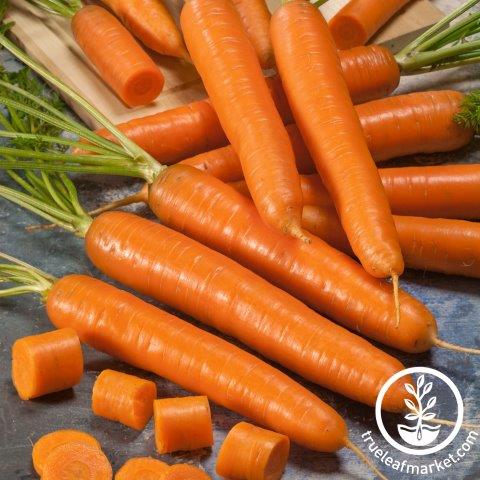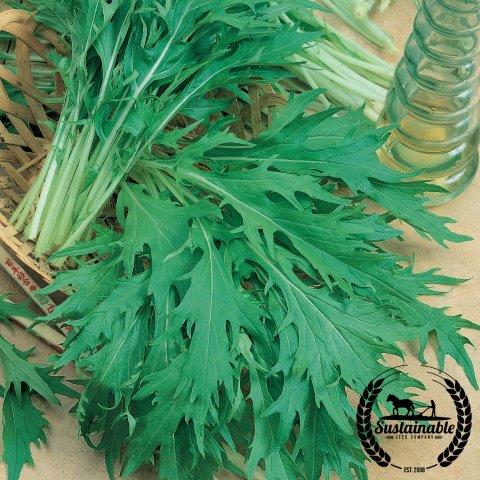Short Season Vegetable Gardening - Early Maturing Varieties
by Ashleigh Smith
Gardening and growing food commercially continue to become a balance of supply, demand, and climate factors. It’s no secret climate and local weather continue to affect how we grow our food. If you find yourself in an area with short growing seasons (less than 120 growing days) or lingering winter weather, you may be looking for vegetables that can handle the cold or grow a bit quicker than traditional varieties. Below we have supplied you with some reliable quick to mature and short-season vegetable varieties to help you get a jump start, or last-minute results. You can still have a successful growing season while getting a later start than usual.
Long Season Vegetables
Early Maturity Varieties
Tomatoes
Tomatoes should be started indoors ahead of time as their days to maturity do not include the standard 7-9 weeks spent indoors before transplanting. The upside of this is that you can still get your garden started by growing these seeds indoors amid poor weather. Once they reach the point of growth where they could be transplanted, but poor weather persists, simply transplant them into larger containers to keep them healthy until they can be planted outdoors.

Early Girl Hybrid
- Cherry - Sungold Hybrid
- Salad - Quedlingburger Furhe Libe (Indeterminate), Stupice (Semi-Determinate), and Glacier (Determinate)
- Paste - This type generally takes longer than others to mature. La Roma III Hybrid (Determinate), and Roma (Determinate)
- Slicing - Early Girl Hybrid (Indeterminate), Early Doll Hybrid (Determiante), Katana Japanese Hybrid (Semi-Determinate), and Fireworks (Indeterminate)
Corn
Corn grows best when directly sown after all danger of frost has passed. This may make it difficult to grow in a shortened growing season. Grow Early Sunglow Hybrid, peaches and Cream Hybrid, and Honey Select Hybrid for a speedy harvest within 60-80 days.

Early Sunglow Hybrid
Peppers
Like tomatoes, peppers should also be started 7-9 weeks ahead of time indoors. Their days to maturity reflect the time left after transplanting. Take advantage of the need for these seeds to be started indoors during cold weather, as you can increase their pot size until weather permits transplanting outside. The following recommendations can reach maturity in 60-70 days after transplanting.
- Sweet - Chablis Hybrid, Mini Bell Red, and Mini Bell Yellow
- Hot - Cayenne Espana Hybrid, Jalapeno, Sandoval Hybrid, and Fuego Trail Hybrid
Eggplant
Like tomatoes and peppers, eggplant also requires starting indoors for those with short growing seasons. Start seeds 7-9 weeks early indoors. The following recommendations will mature within 2 months of transplanting outdoors when the above recommendation is followed for starting seeds indoors.

Eclipse Hybrid

Fairy Tale Hybrid

Millionaire Purple Hybrid

Gretel Hybrid
Melons
Melons prefer being directly sown, which makes growing them in short growing seasons a little difficult. These varieties will help you get the harvest you want under a time crunch (70 days).

Tuscany Cantaloupe

Golden Delicious Cantaloupe

Green Striped Pickling Melon

Gallo Galia Melon
Watermelon
Traditional watermelons are known to require a long growing season to mature, however, watermelons are available in varying sizes that expand your options for a juicy fruit that can be harvested quickly. These recommendations can mature in 60-70 days with warm growing conditions.

Royalty Hybrid (Picnic, Seeded)

Grandeur Hybrid (Picnic, Seeded)

Early Crimson Treat (Icebox, Seeded)

Tiger Doll Hybrid (Icebox, Seeded)
Winter Squash
Winter Squash will take much longer than summer squashes to mature. However, these varieties will mature in 80 days or less.

Pilgrim Butternut Hybrid

Table king Bush Acorn

Table Princess Hybrid Acorn
Popular Short-Season Vegetables
(Harvest in 2 Months or Less)
Beans
While there are many bean categories, they all can be funneled into two main types, bush or pole. Bush types are more compact and tend to mature more quickly. Within this category, you can find several Snap Bean options. These are also known as green beans. For a speedy green bean harvest, target bush snap beans such as Provider and Contender. These will be ready for harvesting about 50-60 days from planting. Shelling Beans require allowing the seed to mature, which naturally requires several additional weeks until harvesting.
Beets
Beets are ideal for spring and late summer sowing as they prefer cooler temperatures. This can be helpful when under a time crunch as they can handle cooler soil temperatures and may be sown at least twice within a growing season. Generally, beets take 50+ days to mature, although the greens may be harvested around 30 days from planting. We would recommend growing Early Wonder and Red Ace Hybrid for a tasty and quick option.

Early Wonder Tall Top Beet
Broccoli
Broccoli is already a cool-season vegetable making it a favorable option when persistent winter weather encroaches into the spring months. While it doesn’t need to be started indoors, it certainly can help you get a strong harvest in before the weather gets too warm. Additionally, you may want to try a variety such as Di Cicco, which is able to mature in as little as 45 days.
Carrots

Bambino Carrot
Carrots by nature can be harvested at varying degrees of growth. Really, you can harvest them as small or large as you would like, and their genetics allow. Shorter varieties will mature the quickest. Some of our fastest-maturing carrot varieties include Little Fingers, Parisian, Shin Kuroda, Bambino, and Scarlet Nantes.
Cucumbers (Warm Season)
Cucumbers can be divided into two main categories, including slicing and pickling types. In addition to these categories, the type of pollination requirements should be taken into account when selecting cucumbers. To keep things simple, we will be recommending monoecious varieties as these plants will produce both male and female flowers allowing for pollination to take place and produce viable fruits. Cucumbers prefer warm growing temperatures making these fruits ideal for growing after the danger of frost has passed. While they can be started indoors 3 weeks early, they really prefer to be directly sown. To help you get a quick harvest within 2 months of a limited growing season, try the following recommendations.

Boston Pickling
- Slicing - Brown Russian, Eversweet Hybrid, and Garden Sweet Burpless
- Pickling - Boston Pickling, Double Yield, and Pick a Bushel
Collards, Kale, Mustard, Turnips
Leafy greens are generally quick to mature, including these more unique and flavorful types. Try one of these early maturing varieties to keep the healthy leafy greens around. Harvest just a few leaves or whole plants before warm weather affects their taste.

Georgia Southern

Red Russian kale

Red Giant Mustard

Seven Top Turnips
Bok Choy, Mizuna, Tatsoi
Asian greens are, for the most part, quick to mature. This makes them a no-brainer to include in your late-start gardens and early harvesting. Keep a fresh weekly harvest by succession planting a few days or weeks apart. Like other leafy greens, you may harvest a few leaves At a time or the whole plant.

Bok Choy

Mizuna

Tatsoi
Lettuce
Because lettuce will bolt with hot summer temperatures, it is best to grow in the spring and late summer/fall seasons. During the heat of the summer, lettuce can continue to be grown indoors or using hydroponic systems very easily. And they don’t take up much room indoors. For the fastest harvest, regardless of what season you choose to grow in, leafy non-heading types will grow the quickest. Leaf lettuce is available in an assortment of colors and textures. If you prefer heading types you will want to try Jericho (Romaine), as it is quick to mature and bolt resistant.
Spinach
Spinach is another leafy green that traditionally does very well during the cool spring and fall months. It is also one of the first crops you can directly sow outdoors in the spring. For the fastest maturity, try growing Viroflay, Early Hybrid No. 7, Bloomsdale, Seaside, and America varieties. You can harvest spinach at the baby leaf stage within 25-30 days or wait until they reach maturity within 2 months from planting.

Early Hybrid no. 7
Onion
Bulbing onions, by nature, take time to develop. Although, some cocktail or pickling types can mature quickly. If you are looking for some quick onion flavor though, we recommend turning to green bunching onions. These can be ready to harvest in 60 days and do not require a specific day length to develop. For the fastest results, grow the White Lisbon or Evergreen varieties.
Peas
Peas are one of the best vegetables to start your garden with as they can often handle the last-minute spring frosts that may occur. Peas germinate in cool soils allowing you to directly sow when the soil is workable. If you find yourself approaching warming temperatures and are needing a quick harvest, there are several good options for you to grow.
- Shelling (Non-edible Pod) - Alaska, Progress No. 9, Little Marvel, Patio Pride, Lincoln
- Snap (Edible Pod) - Cascadia, Super Sugar Snap, and Sugar Sprint
- Snow (Edible Pod, minimal pea) - Oregon Sugar Pod II, Mammoth Melting Sugar Pod, Dwarf Sugar Grey
Radish
Radishes are definitely going to be one of your fastest-growing vegetables. Many can be harvested in less than a month’s time. For the traditional red globe vegetables, you will want to look for spring types. Radishes can be categorized into 3 groups including spring, winter, and sprouting. Spring varieties develop quickly and are delicious for eating fresh. These spring varieties are known for harvesting within a month: Cherry Belle, French Breakfast, Hailstone, and Pink Beauty.

Hailstone Radish
Winter types take longer to mature and have an elongated shape. Daikon (Minowase) varieties are included in this category. While they do take longer than spring varieties to mature, the Mino Early, Everest Hybrid, and Iwai Daikon can be ready in 2 months or less.
Sprouting types are ideal for growing as fresh sprouts and microgreens. At this stage, radishes can be ready to eat within 3-8 days. There is also no need to grow these outside as they are ideal for growing in the kitchen or windowsills.